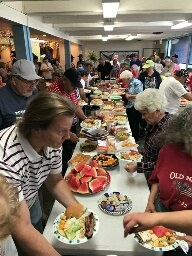Neighborhood Toolbox
Roles and Responsibilities of Neighborhood Association Board Members
Depending on the structure of your association board and bylaws, there can be several leadership roles within a Neighborhood Association. When new board members are elected, it is always helpful to clearly explain the specific expectations of their role once they have joined.
The Importance of Having an Electronic File Share System
Setting up a shared document system helps with board members transitions, creates a sense of transparency, and can help with accessibility of documents.
You want to be part of this!
Want to grow your neighborhood involvement? Try developing an effective elevator pitch that you can use anywhere in your neighborhood to talk about the benefits of getting involved. Help your neighbors know they want to be part of what you're doing in the neighborhood!
Using Nextdoor - Helpful Tips and Suggestions for Neighborhood Associations
Have you joined Nextdoor yet? It’s a private social network that allows people to share information within a specific geographical area, post events, communicate concerns about criminal activity, and generally connect with people that might have similar interests and concerns.
Recruiting and Retaining Members
Tangible tips on finding new members and keeping them engaged long-term!
Be Goal-Focused
What steps can a neighborhood association take to become better organized and more focused in its planning?
Preventing Polarization in your Association
All the skills of communication, conflict resolution, and collaboration are ways to prevent conflict from escalating into polarization which divides a community. However, it is important to pay attention for warning signs because polarization can be so damaging.
Turn Dispute into a Deal
Learn how your association can have the quality, respectful discussions necessary to speak with ‘one voice’ by using principled negotiation to turn the dispute into a deal.
Building Consensus
Learn how your association can have the quality, respectful discussions necessary to speak with ‘one voice’ by building consensus.
Planning for a Successful Meeting
Good meetings are the result of a few consistent practices. Prepare well.
Modeling Respect as a Leader
Ways that a leader can model respect and develop a respectful climate in their organization.
Building Trust as a Leader
Watch for opportunities to develop a working level of trust with others in your association and your neighborhood. How can you apply these proven principles for increasing trust?
Setting Appropriate Boundaries
Some ideas on how to set limits, so others recognize and change inappropriate or disrespectful behavior.
Making Meetings Fun and Interesting
Holding meetings that appeal to many people can be a challenge, because so many different types of people attend and each one of them listens, sees, and processes information differently. Here are some suggestions for having meetings that are both productive and fun!
Moving Forward Through Challenging Conversations
Methods to have a challenging conversation that will clear the air and ultimately, help you move forward together.
Maintain Your Self-Control
Learn how to respond instead of react to a situation by maintaining your self-control.
Nonprofit Organizations
This section will help you understand the basics of nonprofit structures. Please note that this information is meant to be an overview. Please consult your attorney when making business decisions.
Local Funding Sources
One of the best places to begin researching potential funders is in your home community.
Grant Research Guide and Tools
Identifying funders that align with your mission and goals is key to successful grant seeking.
Grant Application Processes
Before you start writing, you want to assess your eligibility, prioritize which grants to write, and assess your capacity and time for writing and managing each potential funding source.
Basic Information on Obtaining Nonprofit Status and Fiscal Sponsorship
Some basic minimum requirements for attaining a nonprofit ruling from the IRS are detailed below.
Application Components: Program Design
The Program Design section is where you will describe all components of the proposed program, the service delivery method, established best practices, and your experience implementing this program.
Application Components: Organizational Capacity
The bottom line here is not to be afraid to brag. Your neighborhood association has unique assets that no other organization does. Find the ones that relate to your proposal and describe them in detail here.
Application Components: Need Statement
A need statement establishes the problem that the proposed program or project will tackle.
Application Components: Goals, Objectives, Outputs, and Outcomes
While you will want to match the funder’s definitions, it will be important to understand the difference between goals, objectives, outputs, and outcomes.
Application Components: Evaluation and Conclusion
Evaluation is where you describe how you measure progress and results, and conclusion is where restate the purpose of your grant proposal and the outcomes that can be expected if you receive funding.
Application Components
Grant proposals have several components, and this section will guide you through the typical sections in most proposals.
An Introduction to the Grant Writing Toolkit Series
Neighborhood associations have the potential to benefit from grants as a source of funding.
A Warning About Grant Writing
While the payoff can be worth it, it is important to go into the grant-writing process with realistic expectations.
Types of Grantmaking Organizations
There are several different types of organizations that may present funding opportunities for your neighborhood association.































